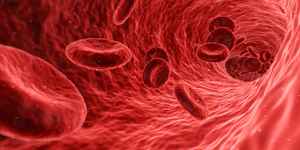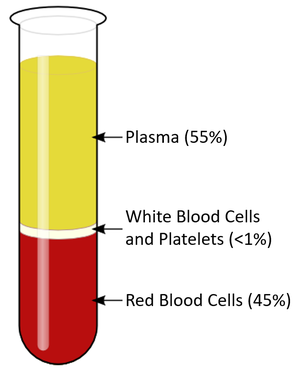Blood
Contents
Key Stage 1
Meaning
Blood is a red liquid found in some animals.
| A drop of blood. |
Key Stage 2
Meaning
Blood is a red liquid that carries oxygen and nutrients to every part of the body.
About Blood
- Blood is pumped around the body by the heart.
- Blood goes around the body in blood vessels.
- The blood is transported around the body to give every organ oxygen and nutrients.
- Blood can be bright red or dark red.
Key Stage 3
Meaning
Blood is a fluidic tissue found in blood vessels that carries oxygen, nutrients and waste products for transport around the body.
About Blood
- Blood is pumped around the body by the heart.
- Blood goes around the body in blood vessels.
- The blood is transported around the body to give every organ oxygen and nutrients.
- Blood can be bright red or dark red.
- Blood is a tissue made from red and white blood cells and a fluid called plasma.
| A picture showing red blood cells going through a blood vessel. |
Key Stage 4
Meaning
Blood is a fluidic tissue found in the Circulatory System that carries oxygen, nutrients, waste products and hormones for transport around the body.
About Blood
- Blood is a tissue made from red and white blood cells, platelets and a fluid called plasma.
- The different parts of blood can be separated by a centrifuge.
- Blood is pumped around the body by the heart.
- Blood goes around the body in blood vessels.
- The blood is transported around the body to give every organ oxygen and nutrients.
- Oxygenated blood is bright red and deoxygenated blood is dark red.
| A diagram showing the percentages of the different parts that make up blood. |
References
AQA
- Blood, pages 52-53, 91, 162-165, GCSE Biology; Third Edition, Oxford University Press, AQA
- Blood, pages 54-6, GCSE Biology, Hodder, AQA
- Blood, pages 80, 81, GCSE Combined Science Trilogy; Biology, CGP, AQA
- Blood, pages 86, 87, GCSE Biology, CGP, AQA
- Blood, pages 86-7, 89, 99, 101, 102, 112-7, 189, 204, GCSE Biology; Student Book, Collins, AQA
- Blood; capillary, page 107, GCSE Biology; Student Book, Collins, AQA
- Blood; circulation, pages 51-3, GCSE Biology, Hodder, AQA
- Blood; glucose, page 192-5, GCSE Biology; Student Book, Collins, AQA
- Blood; glucose, pages 151-5, GCSE Biology, Hodder, AQA
- Blood; plasma, 201, GCSE Biology; Student Book, Collins, AQA
- Blood; pressure, pages 113, 130, GCSE Biology; Student Book, Collins, AQA
- Blood; transfusion, page 30, GCSE Biology; Student Book, Collins, AQA
Edexcel
- Blood, page 61, GCSE Combined Science; The Revision Guide, CGP, Edexcel
- Blood, page 89, GCSE Biology; The Revision Guide, CGP, Edexcel
- Blood, pages 114, 115, GCSE Combined Science, Pearson Edexcel
- Blood, pages 166, 167, GCSE Biology, Pearson, Edexcel
- Blood, pages 262, 263, GCSE Biology, CGP, Edexcel
- Blood; clots (locating), page 172, GCSE Biology, CGP, Edexcel
- Blood; deoxygenated, page 116, GCSE Combined Science, Pearson Edexcel
- Blood; deoxygenated, page 168, GCSE Biology, Pearson, Edexcel
- Blood; glucose concentration, page 56, GCSE Combined Science; The Revision Guide, CGP, Edexcel
- Blood; glucose control, pages 106-107, GCSE Combined Science, Pearson Edexcel
- Blood; glucose level, pages 238-241, GCSE Biology, CGP, Edexcel
- Blood; groups, page 41, GCSE Biology; The Revision Guide, CGP, Edexcel
- Blood; groups, pages 115, 116, GCSE Biology, CGP, Edexcel
- Blood; oxygenated, page 116, GCSE Combined Science, Pearson Edexcel
- Blood; oxygenated, page 168, GCSE Biology, Pearson, Edexcel
- Blood; vessels, page 62, GCSE Combined Science; The Revision Guide, CGP, Edexcel
- Blood; vessels, page 90, GCSE Biology; The Revision Guide, CGP, Edexcel
- Blood; vessels, pages 264, 265, GCSE Biology, CGP, Edexcel
OCR
- Blood, page 31, Gateway GCSE Combined Science; The Revision Guide, CGP, OCR
- Blood, page 38, Gateway GCSE Biology; The Revision Guide, CGP, OCR
- Blood; blood vessels, pages 74-75, 117, Gateway GCSE Biology, Oxford, OCR
- Blood; circulation, pages 74-76, Gateway GCSE Biology, Oxford, OCR
- Blood; clotting, page 222, Gateway GCSE Biology, Oxford, OCR
- Blood; components, page 77, Gateway GCSE Biology, Oxford, OCR
- Blood; defence mechanisms, pages 222-223, Gateway GCSE Biology, Oxford, OCR
- Blood; menstrual cycle, page 104, Gateway GCSE Biology, Oxford, OCR
- Blood; plasma, page 77, Gateway GCSE Biology, Oxford, OCR
- Blood; red blood cells, page 28, 31, 61, 67-68, 77, Gateway GCSE Biology, Oxford, OCR
- Blood; sickle cell anaemia, page 162, Gateway GCSE Biology, Oxford, OCR
- Blood; stem cells, page 68, Gateway GCSE Biology, Oxford, OCR
- Blood; sugar levels, pages 118-119, Gateway GCSE Biology, Oxford, OCR
- Blood; water potential, page 123, Gateway GCSE Biology, Oxford, OCR
- Blood; white blood cells, pages 77, 223, 226, Gateway GCSE Biology, Oxford, OCR


